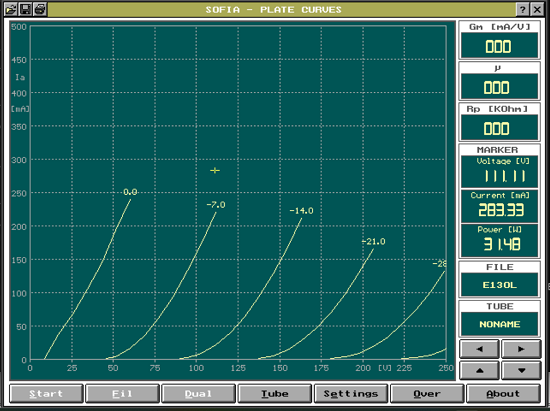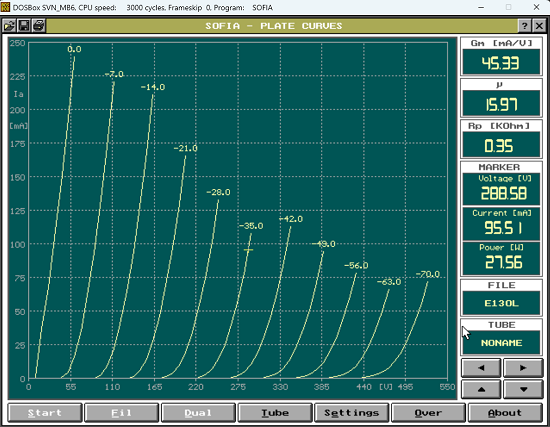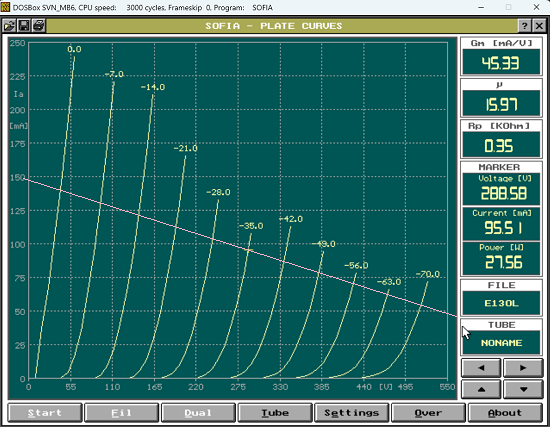Portrait of a Tube
Description of the E130L tube
This is very unusual tube. Both in it's appearance as well as technical data. From the data sheet, first thing you see, is the enormous cathode power. So 10.7Watt heating power is really a lot. Looking inside the tube, shows the a very flat and wide cathode. Which is needed for very high peak current, because no matter how you design a tube, there the maximum current density in A/cm², which is physically limited. So you can not just specify a lot of peak current, at very low voltage. Even though this would not overheat the anode, it would chip off particles of the cathode. So we see this very current of 300mA, and it just means the cathode must be twice 2x wider as a tube which can do 150mA, even at the same anode dissipation. So that explains this very unusual, wide cathode.
This high current capability makes it a perfect tube for regulated power supply, and also for OTL amplifiers, as the datasheet writes. Moreover, since such a cathode can as well be seen as two "normal" cathodes in parallel, it comes as not surprise this tube has a low Plate impedance. It is insane low, I measured 340 Ohms in Triode Mode. (More about this later)
THIS is just a specualtion, but I think it is right: 27 Watt dissiaption is not in line with what I see inside the bulb. Also the tube feel so heavy. Can this BIG tube do only 27 Watt? I would not be surprized if it can do more than 27 Watt in a less harsch application. (Which is called: SIngle Ended)
The VERY strange Triode curves
Moreover, I found the TRIODE curves of this tube, in the data sheet looked to STRANGE, I decided to measure the triode curves a a NOS tube myself, using the SOFIA Curve tracer. The result was unexpectedly good, and COMPLETELY different as in the data sheet. So it the data sheet wrong? Well, I can not really say, because an official Triode Mode specification is not given in the data sheet. There is only these Triode curves, and NO TRIODE Specifications! Sort of saying "it is possible, but you are on your own....".

Above is a copy of the Triode curves, and as you can see, they are distorting very heavily, they need 200mA or so, and only 140 Volt. Frankly, pretty useless. But is that really so? No it is not! That is because they simply represented this tube in it's typical use condition, emphasizing it's incredible high current capability. If we want to us it for HiFi, why do we force ourselves into this high current part of the curves? That only makes the SE transformer difficult. Why not just use it at 70 or 95mA, and have better transformer performance? Well, and then comes the problem the curves are not drawn to represent this.
My first thought was, the curves look nice ABOVE 27 Watt, where I am not allowed to use them, and they look pretty bad below 27Watt.
Also, if I may say this, I do not believe the curves bend away so extremely in the 20mA range, as the graph tells. So yes, all tube curves curves bend at the bottom, but..... there is one curve (with indirect heated tubes) which does NOT do so. It the 0V curve. Actually the positive grid voltage curves bend in the opposite direction, and positive and negative curves group around this 0V curve, which starts as a straight line. But here, it seems the 0V curves is made (by hand) to look like the others. Also, if you look at the point 40V, 0mA, you can see the curve does not fit in there nicely. The same I see at 130V, 130mA. Not saying this is bad work, or wrong, but I can say, these curves are not made by hand in some way.
The next charts is with the Sofia, and the same as in the data sheet, measured points are comparable. Just the grid step here is 7V ( Reason for this will follow)

Note, the ABOVE is the same representation as in the data sheet.
Now without changing the test data, we can change the scales of the curves. Both curves use the same test data. (You can check it). So in the next picture is also a grid step of 7V, current max 250mA, but we show no the plate up to 550V.

And now look.... Curves made from a NOS E130L. The curves are magnificent. I set the cursor to 95mA, 288V, and the tube has following data there:
Gain=16
Rp=350 Ohms

This is with a load line if 2k8. At 450V peak to peak, which is 159V RMS, an output power of 9 Watt would result from this.

This is load line of 5k, which is too high. Just to see what it does. This gives appr 171V RMS, so appr 5.8 Watt, at slightly less distortion, but for less distortion you may as well take the previous curve, and drive it only to 5.8 Watt as well. Only then you have power reserve up to 9 Watt.
Conclusion
I have never tried it with a real tube, but I am pretty sure E130L in Triode mode belongs to the most perfect NOS tubes there is.